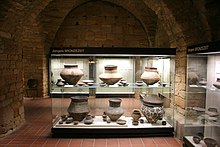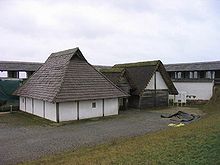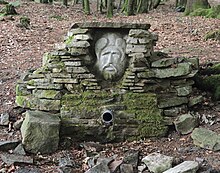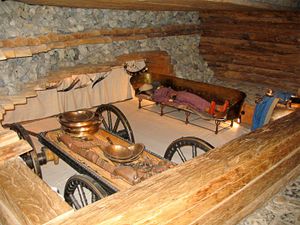
Largest Celtic expansion around 275 BC Chr.
Lusitania (Celtic settlement uncertain)
The six "Celtic Nations" with Celtic languages in modern times
Today's area of circulation for Celtic languages
The Celts occurred around 800 BC. out of the dark of history. It was a group of peoples with a common culture and language that subsequently spread west to the Iberian Peninsula, north to the British Isles and east to the Balkans. The name Celts probably used it themselves, or maybe it came from historians like Herodotus. The Roman Caesar referred to these peoples as Gauls. To the north of the Celtic settlement area, another people lived initially, to whom the Celts took their name Germanic peoples gifts. This article discusses aspects of Celtic culture dating back to 800 BC. until it was Romanized and Christianized.
background

history
There were several dozen Celtic tribes such as the Helvetierwho have favourited Belgae, the Arverner or the Treverer. They were not always fraternal with one another, as the writings of Caesar and Tacitus show.

The history of the Celts begins in Central Europe around 800 BC. with the end of the Bronze Age and the transition to the Iron Age. It is not entirely clear from what point in time one can speak of Celts or which tribes can be called Celts, as there are hardly any written documents from the time before the conquest of Gaul. Archaeological finds can be used as evidence. The tombs from the corresponding epoch are ideal for this.
- Urnfield culture: it is the most widespread Central European burial culture of the late Bronze Age. It existed from about 1300 to 800 BC. Since the burial rite - burning of corpses on a stake and burial of corpses in urns - was also practiced in other cultures, the urn field culture is defined by further criteria, such as typical bronze and ceramic shapes. The urn field culture followed the barrow culture of the Middle Bronze Age. In many parts of its area of distribution, the urn field culture was replaced by the Hallstatt culture at the beginning of the Iron Age.

- Hallstatt period: In 1846 a field with over 1000 graves was discovered on the Salzberg in Hallstatt, in which, in addition to the cremation graves and urn burials that were customary at the time, there were also body graves in which the bodies of the dead were buried intact. This resulted in a time gradation: the urn grave culture ended around 800 BC, in the Hallstatt culture burial in grave fields became common. In these body graves, the grave goods were usually more diverse than in the cremation graves, and the sex of the dead could also be determined on the basis of the objects. This resulted in a further differentiation of the times: Hallstatt Ha A and Ha B are still in the Bronze Age, followed by the times Ha C and Ha D, which are in the Iron Ages. Not very clear and also not a very exact time. And depending on the presence of additions, the graves and thus the tribes were divided into a West Hallstatt district and an Osthallstatt district. But around 450 BC. the Hallstatt period was over, La Tène was announced.
- La Tène period: In the west of the Celtic settlement area there was a brisk trade with peoples from the Mediterranean area. Weapons, jewelry and metallic objects were traded. These were decorated with patterns that the Celts did not know until then, but which they found good, copied and further developed. A part of the merchandise could be dated, and so a new chronological classification resulted: End of the Hallstatt culture around 450 BC, beginning of the Latène period, duration up to approx. 100 BC. Or up to the year 0. Of course, again subdivided into several time groups.
- Romanization: Then the Romans came and defeated them Gauls, like it Caesar described. Then came the Cimbri, then the Teutons, in short: the Teutons were on the move, some of them as far as the pillars of Heracles. The Celts also migrated, the British Isles were a popular destination, then some of them came back as missionaries and Christianized the Teutons. On the European mainland, the history of the Celts was largely over.
language

If you want to develop a feeling for the Celtic language, you can find it in Brittany or Wales. If one goes by the phrase "Celts are those who speak Celtic", there are hardly any members of this people in Central Europe. Yet most of us know some names of Celtic origin. Examples are the names of the rivers Altmühl, Main, NeckarYou know immediately where this people lived. And where the god Rhenus was located, is also evident from its name.
Celtic art
In the Hallstatt period, Celtic jewelry such as bracelets, fibulae and rings were only decorated with simple geometric patterns. In the subsequent La Tène period, new motifs were added, such as those known to the Etruscans, for example. Mention should be made of leaf tendrils and abstract sculptural patterns. It was in this epoch that what we understand today as Celtic art began. Many of these pieces of jewelry were made of bronze, they were partly decorated with amber, with coral or with enamel. On the one hand, this testifies to the diverse trade relationships across Europe, but also to the skill of the Celtic craftsmen. These motifs were further developed by the Celts living on the British Isles after the turn of the century, this is an example Celtic cross.
The Celtic Society

Details of the structure of the Celtic social order have been handed down to us by historians such as Tacitus and Caesar. It is therefore known that the Celtic princes of different tribes maintained contact with one another, but that there was no unified Celtic nation. It is also assumed that one can distinguish between three social classes: nobles - free - unfree. Chains were found at some sites, so it is possible that some tribes also had slaves.
Celtic princes: It is not entirely clear whether the leaders of the tribe received their position in the upper class through inheritance or through election. When a Celtic prince is mentioned, it can also refer to a person who plays a prominent role in local society. It is also recorded that in the late La Tène period women were also regarded as princesses. Some of the Celtic tribes were ruled matriarchally. In general, women had more rights than the Romans.
Cult figures: The nobles also include them Druidswho, after long training and experience, were said to have the skills to prophesy and advise princes. Often the druids also had priestly functions and they had knowledge of diseases and remedies.
One can also be one of the cult figures Bards calculate (also as Filid designated). Their task as poets and singers was to preserve the legends and stories of the clan or the tribe and to spread them orally. Just like the Druids, they had the ability to prophesy and knowledge of medicine. Then there was the Dadswho acted as priests. These seers also worked as healers or as priests.
The peasants, craftsmen and warriors belonged to the second social class of the free.
The lower class of the unfree consisted of slaves or prisoners of war.
Celtic mythology

In contrast to legends, myths have religious content and they were often dealt with in a rather mysterious way. The druids were primarily responsible for this, they were responsible for the religious rites and ceremonies. However, it was difficult to pass it on exactly over several centuries, mainly because most of the Celts at that time had no writing available. In addition, different content has crept in over the course of several generations. An example: all peoples use a calendar, and most dare to look into the future with the help of a horoscope. This is still the norm today. But there is little point in portraying this as Celtic culture, even though it was never used in that form in Celtic times. That includes such fancy things as that celtic tree horoscope. It is an invention of our time that the Celts did not know about.
The legends of the Celts, however, have been handed down much better. This is proven by King Arthur and Parzival, whose stories were written down and circulated in the British Isles. Some small glimpses of mythology can be found in the funeral rites and, above all, in the grave goods. Drinking vessels or weapons suggest that there is a belief in continued life in one Otherworld gave. The addition of jewelry also suggested the social status of the dead. The various decorations on the objects also allow conclusions to be drawn about the religious ideas of the Celts. Examples are
- Plant mythology: Mistletoe as a medicinal plant, see Miraculix
- Cauldron myths: the cauldrons are seen as vessels of healing or rebirth, they serve as magic cauldrons.
- Animal myths: Animals have been assigned certain characteristics, e.g. the bear is a symbol of strength, horses and dogs are companions of the gods.
- Head cult: The Celts believed that if you own a head, you also have strength and knowledge of the person.
Tourist Attractions

- 1 Heuneburg (fortified hilltop settlement from the Hallstatt period). The Heuneburg is probably the one described by Herodotus City of Pyrene. It is located on a plateau on the upper reaches of the Danube in the Hundersingen district of the municipality Herbertingen. A first settlement in the Bronze Age was around 1200 BC. abandoned again. Around 600 BC. the so-called "Princely Seat" was created. During this time there were also some burial places, such as the Bettelbühl burial ground created. Several thousand people lived on the Heuneburg and in the surrounding area before it was destroyed again by fire.
- An open-air museum on the Heuneburg and the Heuneburg Museum in Hundersingen are well worth seeing.
- Not to be confused with the Celtic ring wall of the same name Fischbachtal

- 2 Ipf. The Ipf towers over the city Bopfingen He is considered a witness mountain of the Swabian Alb. There is a prehistoric fortification on its summit plateau. Furthermore: an archaeological open-air museum.
- 3 Heidengraben. The Celtic oppidum from the 1st century. B.C. is considered one of the largest Celtic settlements in Central Europe. She is at the village Grabenstetten located on the northern edge of the Swabian Alb.

- 4 Celtic grave mound Hochdorf. Burial mound from the Hallstatt period. Prince's grave around 550 BC. at the Celtic Museum in the Eberdinger district of Hochdorf near Asperg (LKr. Ludwigsburg).
- 5 Magdalenenberg. Hallstatt period, large grave mound, at Villingen-Schwenningen. The burial chamber of the princely grave is exhibited in Franciscan Museum.
- 6 True treasures: Celtic collection of the State Museum Württemberg, Stuttgart (Celtic collection of the Württemberg State Museum, in the old castle). Celtic collection of the Württemberg State Museum. Finds: from the grand grave of Hochdorf, from the graves of Bad Cannstatt, the swordtail from Gomadingen, the warrior from Hirschlanden, the grand grave of Inzigkofen-Vilsingen.
- 7 Oppidum Finsterlohr. archaeological site above the Taubertal near the village of Finsterlohr Creglingen, Educational trail with 6 stations.

- 8 Archaeological Museum Colombischlössle. E-mail: [email protected]. The museum in the Colombischlössle Freiburg shows exhibits from the Stone Age to the Middle Ages. Worth seeing: the Celtic grand tomb of Kappel-Grafenhausen.
- 9 Tarodunum late Celtic oppidum Kirchzarten. The name Tarodunum has survived since ancient times, it denotes a fortification and a nearby settlement. The area is accessed by a hiking trail.
- 10 Schanze and Oppidum on Swabia (Castle ruins in Altenburg, Jestetten)
- 11 Heiligenberg, at Heidelberg, on the north side of the Neckar. The Heiligenberg was already settled in the Neolithic Age. During the urn field culture around 1200 BC. there was a permanent settlement, it was from 500 BC. the cultural center of the region until Roman times. Exhibition in the Palatinate Museum. Brooches and jewelry, horses and chariots with the Celts.
- 12 Thunder Mountain
 . The 686 m high Donnersberg is in the North Palatinate Bergland Kirchheimbolanden. At the top of the mountain is a Celtic rampart from the Latène period.
. The 686 m high Donnersberg is in the North Palatinate Bergland Kirchheimbolanden. At the top of the mountain is a Celtic rampart from the Latène period.

- 13 Celtic world on the Glauberg. Archaeological Museum and Research Center at Glauburg at the foot of the Vogelsberg. The focus is on the find of the Celtic prince from Glauberg.
- 14 Dünsberg ring wall system. The ring wall is included Biebertal on the Dünsberg. Finds are exhibited in the KeltenKeller museum in the town hall.
- 15 Altburg (open air museum), at Bundenbach in the Hunsrück. The small hillside settlement was founded by the Treveri tribe in the 2nd century. B.C. built.
- 17 Manching oppidum. The settlement from the Latène period was located within a ring wall, which had a circumference of 7.2 km. Exhibits are in Celtic-Roman MuseumManching issued.
- 18 Hallstatt (archeology). The place Hallstatt is located in the Austrian Salzkammergut on Lake Hallstatt. Already in the Bronze Age around 1500 BC. Mining was carried out on the salt mountain and salt was extracted.

- 19 Bell's chariot grave. The finds are in the Rheinisches Landesmuseum in Bonn issued. A description of the tomb is in Kastellaun in the castle in the "House of Regional History".
- 20 Oppidum Steinsburg. The oppidum was on the Kleiner Gleichberg. Finds are exhibited in Steinsburg Museum. The 254 km long Celtic adventure trail also begins there.
- 21 Karlsruhe Palace Badisches Landesmuseum. Celtic coins like Stater and Rainbow bowl, Heidelberg head.
- 22 La Tène, La Tène, Marin-Epagnier. The place La Tène NE is located on Lake Neuchâtel in Switzerland, a treasure was under water here for a long time and was only discovered towards the end of the 19th century. A.D. discovered and recovered. It was about 2,500 finds, some of which were richly decorated. These included weapons, agricultural implements, horse harness, jewelry, coins, objects made of wood, metal and ceramics. Some of them could be dated, and this resulted in a new chronological order: End of the Hallstatt culture around 450 BC, beginning of the Latène period, lasting up to approx. 100 BC. Or up to the year 0. Of course, again subdivided into 4 time groups.
- 23 Ring wall of Otzenhausen (Otzenhausen Celtic Park) (at the community Nonnweiler in Saarland). Fortification (oppidum) on the slope of the Dollberg near Otzenhausen.
- 24 European cultural park Bliesbruck-Reinheim (Parc archéologique européen de Bliesbruck-Reinheim), Robert-Schuman-Strasse 2, 66453 Gersheim.
- 25 Archaeological State Museum Baden-Württemberg. housed in the former Petershausen monastery in Constancy.

- 26 Hallein Salt Mine (Celtic village of Salina, Salt mines Hallein, Hallstatt, Altaussee), Ramsaustraße 3. Already around 2000 BC. Salty springs were known on the Dürrnberg. the underground mining of salt began by the Celts. After the Romans established the Celtic Kingdom Noricum the salt mining came to a standstill. Worth seeing: Hallein Salt Mine and Celtic Village SALINA on the Dürrnberg.
- 27 Celtic village Mitterkirchen (in the Mühlviertel in Upper Austria). Reconstruction of a Celtic settlement from the Hallstatt period, open-air museum.
- 28 Belginum Archaeological Park, Keltenstrasse 2, 54497 Morbach. Tel.: 49 6533 957630. Archaeological Museum and Open Air Museum. Burial ground from the Latène period.











.jpg/300px-Celtic_Art_p169_(right_spiral).jpg)





.jpg/300px-Kelten-Ausstellung_Landesmuseum_Württemberg_(06).jpg)





















.jpg/350px-Dürrnberg_(Salzwelten).jpg)

